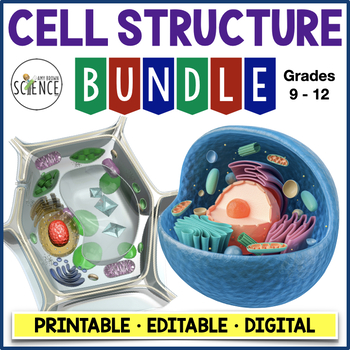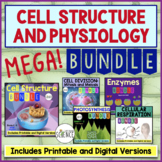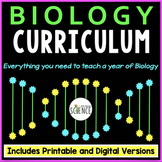Cell Structure and Function Bundle Cell Organelles Cellular Transport Cells
- Zip
- Google Apps™

What educators are saying
Products in this Bundle (21)
showing 1-5 of 21 products
Bonus
Also included in
- Five of my best-selling complete teaching bundles are included in this one Super-Mega-Bundle! This bundle includes all of the PowerPoints, notes, labs, task cards, homework assignments, review games, quizzes, activities, and unit tests that you need to teach complete and comprehensive units on cellPrice $189.99Original Price $268.09Save $78.10
- This NO PREP, PRINTABLE, EDITABLE, AND DIGITAL Biology Curriculum contains everything you need for an entire year of Biology! For less than $3 a day, you can save your time, energy, and sanity. Each of the 20 Complete Units includes a teaching PowerPoint presentation, notes, labs, homework assignmenPrice $525.00Original Price $988.18Save $463.18
Description
This Cell Structure Bundle has you covered from start to finish. It covers the history of cell studies, the cell theory, characteristics of living organisms, prokaryotic and eukaryotic cells, the cell organelles found in both animals and plants, and cellular transport (osmosis, diffusion, active and passive transport).
In short, this complete teaching unit includes everything you need to teach a unit on Cells to your life science or biology students. Resources are available in BOTH printable and digital formats. Resources include a 111-Slide Powerpoint presentation packed with colorful and interesting photographs, teacher notes, student notes, 6 labs, 3 jeopardy review games, 5 quizzes / study guides, cell organelle card sort game, 3 practice worksheets, 2 crossword puzzles, and a final unit exam.
From the engaging PowerPoint to the final unit test, this bundle contains loads of editable and NO PREP materials that are ready to be used with your students. Many of the resources in this bundle are available in paperless digital formats for use in Google Drive, Google Classroom, Microsoft OneDrive, or similar.
What is included in this bundle? ( Items marked with ** have both printable and digital versions.)
- Cell Structure and Function PowerPoint and Notes Set **
- Cell Organelle Card Sort Review Game **
- Lab Variation in Cell Structures and Cell Organelles
- Lab: Osmosis and Diffusion in Living Cells
- Lab Activity: Osmosis and Diffusion
- Lab: The Effect of Concentration on the Rate of Diffusion
- Lab: Diversity of Cell Structures
- Lab: Qualitative and Quantitative Plasmolysis
- Cell Organelles Matching Worksheet **
- Transport Across the Cell Membrane Worksheet **
- Worksheet: The Importance of Surface Area to Volume Ratio in Cells **
- Introduction to Cells Quiz / Study Guide **
- Animal Cell Quiz / Study Guide **
- Plant Cell Quiz / Study Guide **
- Transport Across Membranes Quiz / Study Guide **
- Animal and Plant Cells Study Guide **
- Cell Organelles Crossword Puzzle
- Cellular Transport Across Membranes Crossword Puzzle
- Cell Organelle Jeopardy Review Game
- Cellular Transport Jeopardy Review Game
- Test: Cell Structure and Function and Membrane Transport **
Teacher Guide containing tips for implementing the resources, suggestions for sequencing, and alignment to NGSS standards is also included.
Teacher Answer Key is included for each resource.
The topics covered include the following:
- The History of Cell Studies: Robert Hooke, Anton van Leeuwenhoek, Schleiden, Schwann, and Virchow.
- The Cell Theory.
- Characteristics of living organisms and processes carried out by all cells.
- Diversity in cell shape and size, surface area-to-volume ratio in cells.
- Characteristics common to all cells: Cell membrane, cytoplasm, control center.
- Differences between prokaryotic and eukaryotic cells.
- The Animal Cell: Students will label a drawing of a typical animal cell.
- Detailed information about each of the following animal cell organelles: Cell membrane, nucleus (nuclear membrane, chromatin, nucleolus, nuclear pores, nucleoplasm), ribosomes, rough and smooth endoplasmic reticulum, Golgi apparatus, vesicles, lysosomes, peroxisomes, vacuoles, mitochondria, cytoskeleton, and centrioles.
- The synthesis and transport of proteins through the cell.
- The Plant Cell: Students will label a drawing of a typical plant cell.
- Differences between plant and animal cells.
- Detailed information about each of the following plant cell structures: Cell wall, chloroplasts, chromoplasts, leucoplasts (amyloplasts), and central vacuole.
- The diversity of cellular life: Unicellular organisms, colonial organisms, multicellular organisms, the advantages and disadvantages of cell specialization.
- Levels of cellular organization: Cells, tissues, organs, organ systems.
- The Cell Membrane: Students will label a drawing of the cell membrane. Functions of each part of the membrane are covered: Phospholipids, proteins, transport proteins, cholesterol, and carbohydrates.
- The Fluid-Mosaic Model of the cell membrane.
- Homeostasis and Cell Transport: Definition of homeostasis, how homeostasis is accomplished, permeability of the membrane, the concentration gradient.
- Passive Transport: Definition, diffusion, osmosis, equilibrium, isotonic solutions, hypertonic solutions, and hypotonic solutions.
- Detailed discussion of how animal cells and plant cells respond to isotonic, hypertonic, and hypotonic solutions: Plasmolysis and cytolysis.
- Practice Problems: Given the concentrations of various solutions inside and outside a dialysis bag, students will predict the movement of water and other substances into and out of the “cell.”
- Facilitated diffusion: Definition, carrier proteins, protein channels in the membrane.
- Active Transport: Definition, types of molecules that require active transport to move across the membrane, endocytosis, phagocytosis, pinocytosis, and exocytosis.
For updates about sales and new products, please follow my store:







